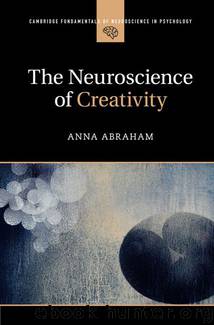The Neuroscience of Creativity (Cambridge Fundamentals of Neuroscience in Psychology) by Abraham Anna

Author:Abraham, Anna [Abraham, Anna]
Language: eng
Format: epub
Publisher: Cambridge University Press
Published: 2018-10-25T07:00:00+00:00
8.3.2 Brain Basis
Timing, sequencing, and spatial organization of action constitute the information processing triad of musical performance (Peretz & Zatorre, 2003 ; Zatorre et al., 2007 ). While parameters related to “ movement timing” are subserved by processing within the cerebellum, the basal ganglia and the SMA, the learning, planning, and execution of sequences that require higher levels of control involve these and additional brain structures in the premotor cortex, the pre-SMA, and the prefrontal cortex. The neural correlates of spatial organization of movement during musical performance are less well understood, with the limited evidence suggesting that the dorsal aspect of the premotor cortex appears to play a significant role. This region is also associated with increased gray matter as a function of early musical training (approximately before the age of 6) (Brown, Zatorre, & Penhune, 2015 ).
The coupling between auditory and motor systems during music performance is orchestrated by feedback and feedforward interactions. Feedback interactions reflect the influence exerted by the auditory system on the motor system , such as tapping to the beat of ambient music. Feedforward interactions reflect the situations in which a movement leads to auditory information and this information can be used to modify further movements, such as during musical practice when motor adjustments are continually made in relation to auditory feedback. The cerebellum, in particular, plays a key role in the optimization of movements as it is involved in error correction and in the learning of new motor skills (Brown et al., 2015 ).
The auditory-motor pathways that facilitate this interaction are anatomically enhanced in musicians compared to non-musicians. The pathways are comprised of dorsal and ventral routes, with the latter involved in the representation of musical intervals, contours, and other melodic features. The dorsal route engages dorsal premotor and parietal pathways in transforming acoustic patterns into motor patterns. Long-term memory, which engages medial temporal lobe structures, and working memory, which engages frontal lobe structures, are also significant in relation to expert musical performance. Long-term memory skills are superior in expert musicians, allowing them to play from memory by recalling not only hundreds of pieces but also their own interpretations of musical work, which they have consciously chosen and extensively rehearsed beforehand. Working memory involves the retrieval, maintenance, and manipulation of musical segments, and the working memory skills of expert musicians reflect planning in advance and doing so in segments (ibid.).
Ensemble music performances necessitate sensorimotor coordination as audiomotor and visuomotor messages are dynamically communicated in real time between the musicians. The “ mirror” and “ echo” systems of the brain are commonly evoked in this context, as overlapping regions of the ventral premotor cortex and the inferior parietal lobule are engaged during action observation, action performance, and while listening to action-related sounds (Volpe, D’ Ausilio, Badino, Camurri, & Fadiga, 2016 ; Zatorre et al., 2007 ). This is taken as evidence of such regions coding for the abstract properties of sensorimotor coupling in representing the meaning of actions. The relevance of such mirror systems is
Download
This site does not store any files on its server. We only index and link to content provided by other sites. Please contact the content providers to delete copyright contents if any and email us, we'll remove relevant links or contents immediately.
The Art of Thinking Clearly by Rolf Dobelli(10324)
Mindhunter: Inside the FBI's Elite Serial Crime Unit by John E. Douglas & Mark Olshaker(9263)
Change Your Questions, Change Your Life by Marilee Adams(7684)
Nudge - Improving Decisions about Health, Wealth, and Happiness by Thaler Sunstein(7658)
Mastermind: How to Think Like Sherlock Holmes by Maria Konnikova(7278)
The Power of Now: A Guide to Spiritual Enlightenment by Eckhart Tolle(5680)
Men In Love by Nancy Friday(5192)
Altered Sensations by David Pantalony(5071)
Factfulness: Ten Reasons We're Wrong About the World – and Why Things Are Better Than You Think by Hans Rosling(4713)
The Confidence Code by Katty Kay(4220)
Thinking in Bets by Annie Duke(4185)
Man and His Symbols by Carl Gustav Jung(4095)
The Worm at the Core by Sheldon Solomon(3450)
Why Buddhism is True by Robert Wright(3423)
Liar's Poker by Michael Lewis(3413)
Three Women by Lisa Taddeo(3393)
The Inner Life of Animals by Peter Wohlleben(3285)
Descartes' Error by Antonio Damasio(3248)
How Music Works by David Byrne(3234)
